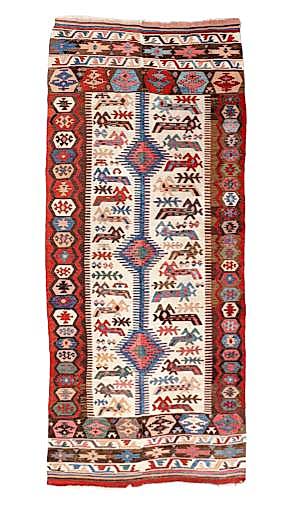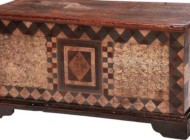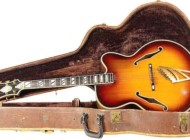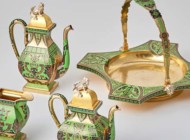
Leading the second day, and the auction overall, was this fine South Coast tunic from the imperial Wari culture, 700-900 CE, which sold for $15,000. These rare codified tunics were only worn by the elite members of society.
Review by W.A. Demers
PHILADELPHIA — Material Culture hosted two days of auctions devoted to fine textile arts and fine rugs, kilims and trappings on June 17-18. Day two saw the highest-priced item in the sale in the form of a fine South Coast tunic from the imperial Wari culture, 700-900 CE, which sold for $15,000. It is not known who originally owned and wore the 3-foot-4-inch-by-6-foot-2-inch garment, but the catalog noted these rare codified tunics were only worn by the elite members of society. The textile featured a wine-colored ground split by two prominent design stripes, each showing repeated serial images of twin interlocking stepped latch hooks — possibly a version of yin and yang — separated by a black line on the diagonal. Warrior head profiles wearing simple caps show edthe essential Wari split eye, square nose and deep prominent mouth. These two motifs were shown in the same form in 80 boxes, while each side selvage featured the same ideas in the unique compressed Wari style. Catalog notes described it as “a tour de force of textile fabrication…[that] displays the wearer’s exceptional nature to all who see it.”
Day one was led by an unusual Navajo weaving, which was possibly a double saddle, selling at $7,500. Crafted circa 1900, the 2-foot-11-inch-by-4-foot-5-inch weaving was of wool pile, wool warp and wool weft. It was the Princeton, N.J. estate of Elizabeth and Richard Ettinghausen, he a German-American historian of Islamic art and chief curator of the Freer Gallery and his wife, an art historian.

From the Ronnie Newman collection, a pair of Nineteenth Century Shahsevan Khorjin Sumak bags, Transcaucasus, attained $6,350.
From the Ronnie Newman collection, a pair of Nineteenth Century Shahsevan Khorjin Sumak bags, Transcaucasus, attained $6,350. And, at $6,000, a central Anatolian woolen kilim from Turkey, early Nineteenth Century, was a rare example of a single-headed zoomorphic figure. There are only three published examples, according to catalog notes.
Another day two heavy hitter was a Balandran alpaca poncho, Seventeenth or Eighteenth Century, which brought $12,700. Exceptionally large and in perfect condition, this piece featured a two-color warp curvilinear snake-like patterned border and a two-color warp zigzag neck trim. Nine multi-colored stripe bands were interspersed with 10 wide unicolor cochineal dyed bands. Four reverse spun stripes on each side were woven into the poncho to ward off evil spirits. The piece was featured in the 1978 exhibit, “Weaving Traditions,” at the Craft & Folk Art Museum in Los Angeles.
A turban from the Sihuas River Valley, South Coast, Sihuas Culture, 100-400 CE, wound up at $10,400. Considered the best of the well-known textile crowns of the Sihuas people, it displayed what are referred to as repeated “spider” images separated by double-headed serpents. Catalog notes explain that those “spider” patterns are actually three yellow stylized shaman figures whose oversized arms, hands, feet and legs link heaven and earth. Their heads are depicted in three slightly different forms atop the rectangular bodies, and the loins below are always in close proximity to the stylized serpents. The torsos contain four-color concentric diamonds and have four-color power stripes emanating from their sides.
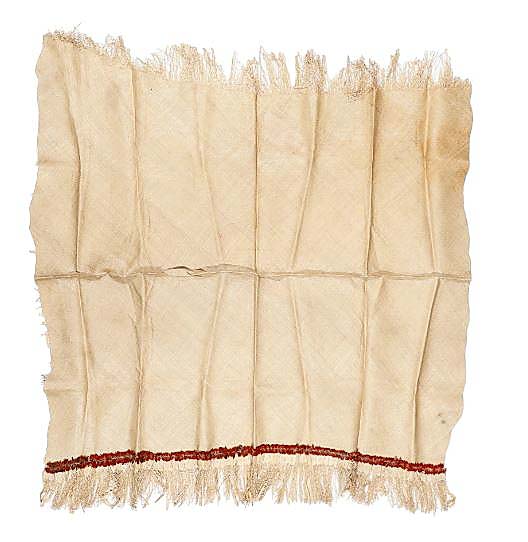
The Samoan ceremonial ‘le Toga — a finely woven mat that held the highest cultural value in the Samoan culture — was traditionally made only by women. Woven of thinly sliced leaves, the mats were not used for sitting. With dimensions of 4 feet 10 inches by 5 feet 6 inches, this mat fetched $6,250.
Fetching $6,250 was a Samoan ceremonial ‘le Toga — a finely woven mat that held the highest cultural value in the Samoan culture. These were traditionally made only by women, forming an integral part of their role and identity within their community. Woven of thinly sliced leaves, they were never used as sitting mats. The mat measured 4 feet 10 inches by 5 feet 6 inches.
Finally, a Nineteenth Century large Greek composite silk embroidery, 7 feet 4 inches by 8 feet 8 inches, made $6,175.
Prices given include the buyer’s premium as stated by the auction house. For information, www.materialculture.com or 215-438-4700.


